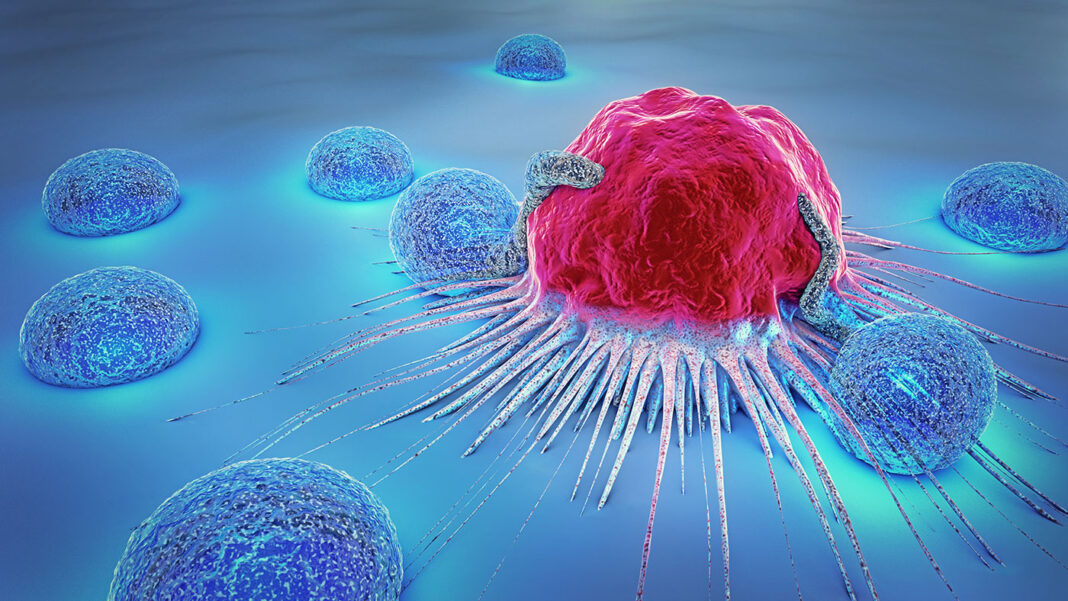Scientists at Trinity College Dublin have discovered that a vaccine adjuvant called C100 promotes potent antitumor immunity when it is injected directly into tumors in an animal model. C100 is derived from chitin, one of the most common building materials in nature, which gives strength to the exoskeletons of crustaceans, insects, and the cell walls of fungi. The newly reported research showed that C100 is highly effective at stimulating a key sensing and signaling molecule, STING (stimulator of IFN genes), that regulates antitumor immune responses. The findings, the scientists suggest, offer promise for developing new immune therapies for cancer.
Joanna Turley, PhD, at the Adjuvant Research Group, School of Biochemistry and Immunology, Trinity Biomedical Science Institute, is first author of the team’s published paper in Cell Reports Medicine. Turley said, “Our work offers detailed new insights into how C100 works, which is critical as you need a functional blueprint to be able to design a therapeutic battle plan, and we now have significant hope that C100 can be developed into a highly effective adjuvant for use in cancer immune therapies in the future.”
Headed by Ed Lavelle, PhD, professor of vaccine immunology in Trinity’s School of Biochemistry and Immunology and based in the Trinity Biomedical Sciences Institute, the researchers reported on their work in a paper titled, “Intratumoral delivery of the chitin-derived C100 adjuvant promotes robust STING, IFNAR, and CD8+ T cell-dependent anti-tumor immunity.”
“The cGAS-STING signaling axis is a crucial regulator of type I interferon (IFN) responses and antitumor immunity,” the authors wrote, and STING represents “a promising target” for adjuvants utilized in in situ cancer vaccination approaches. Lavalle further explained, “In situ vaccines are a form of cancer immunotherapy which aim to transition the tumor itself into a vaccine. For this to work well, you need to use an adjuvant, ‘or vaccine booster’ to kickstart antitumor immunity. As you’d expect there are numerous hurdles to clear even when you have isolated a potential target. One such target is a sensing and signaling molecule known as ‘STING’, but until now adjuvants targeting it have failed to clear some key hurdles in the cellular environment.”
In fact, the authors continued, despite a “plethora” of STING agonists that have been and are being developed, “clinical translation has resulted in disappointingly modest efficacy, and to date, no cGAS-STING-targeted therapy has achieved clinical success,” and no candidate has made it successfully past Phase III trials.
While further work is required, the newly published study characterizes C100’s mechanism of action and offers significant hope that it might clear some of these hurdles and ignite the immune response scientists and clinicians are hoping for. The study in preclinical models showed that intratumoral (i.t.) injection of C100 promoted potent antitumor immunity, and that injection of C100 elicited CD8+ T cell-dependent antitumor immunity via STING and IFN alpha/beta receptor (IFNAR) signaling.
The scientists’ work outlined how C100 exclusively activates the cGAS-STING arm of the signaling pathway without causing inflammatory responses that could interfere with antitumor immunity and which may otherwise prevent therapies from achieving clinical success. “Mechanistically, C100 triggers mitochondrial stress and DNA damage to exclusively activate the IFN arm of the cGAS-STING signaling pathway and elicit sustained IFNAR signaling,” the investigators wrote.
In their paper the researchers concluded: “Altogether, these results reveal an effective STING- and IFNAR-dependent adjuvant for in situ cancer vaccines with a defined mechanism and distinct properties that overcome common limitations of existing STING therapeutics.”
The team’s findings showed that injecting C100 led to synergistic therapeutic effects with anti-PD1 immune checkpoint blockade (ICB) therapy, which is designed to release the brakes on the immune response. “The capacity of C100 to enhance the therapeutic efficacy of PD-1 blockade is particularly promising,” the team stated. “We propose that i.t. C100 therapy could be used both as a monotherapy but also in combination strategies aiming to sensitize tumors to respond to ICB through priming antitumor CD8+ T cell responses … In addition, the local delivery of C100 to the tumor may prove advantageous over systemic immunotherapies where treatment-related adverse effects can be severe.”
The results highlight the potential that C100 has for combination approaches with other cancer immunotherapies, which could help to improve response rates, said Turley. “Our work offers detailed new insights into how C100 works, which is critical as you need a functional blueprint to be able to design a therapeutic battle plan, and we now have significant hope that C100 can be developed into a highly effective adjuvant for use in cancer immune therapies in the future.”
Joint first author, Ross Ward, PhD, added: “In situ vaccination has the advantage of not relying on identifying highly variable vaccine neoantigens, but requires potent and targeted adjuvants that can induce protective antitumor immunity. Our research indicates that C100 has substantial potential in this setting.” Noting limitations of their study, the team nevertheless concluded, “Taken together, while there are limitations, our work provides a strong basis to pursue C100 as a cancer immunotherapeutic agent.”
Lavelle is a co-founder and equity holder of AilseVax, which aims to develop adjuvants for cancer vaccination. Three other study authors, Ross Ward, Joanna L. Turley, and Natalia Munoz Wolf, are also equity holders of AilseVax.


